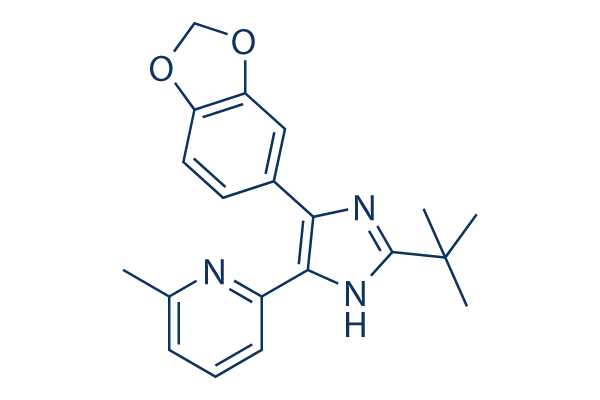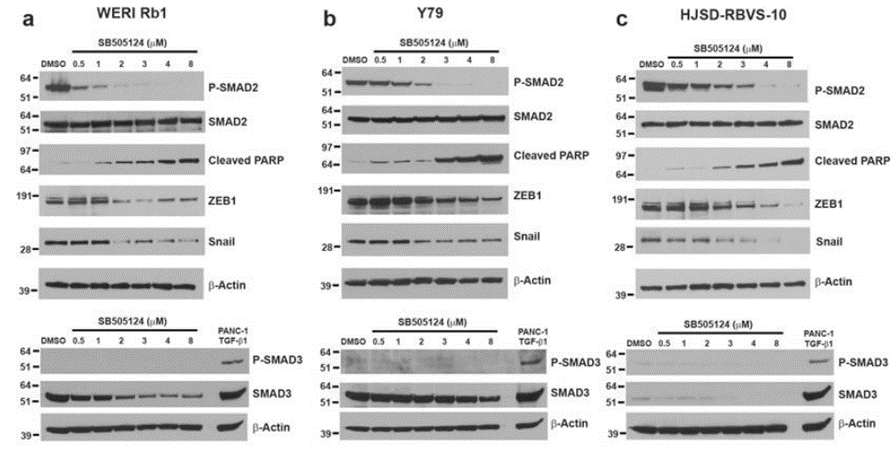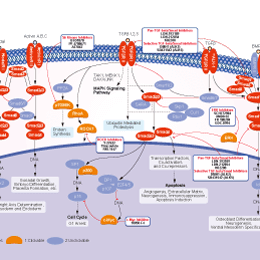
- Bioactive Compounds
- By Signaling Pathways
- PI3K/Akt/mTOR
- Epigenetics
- Methylation
- Immunology & Inflammation
- Protein Tyrosine Kinase
- Angiogenesis
- Apoptosis
- Autophagy
- ER stress & UPR
- JAK/STAT
- MAPK
- Cytoskeletal Signaling
- Cell Cycle
- TGF-beta/Smad
- DNA Damage/DNA Repair
- Compound Libraries
- Popular Compound Libraries
- Customize Library
- Clinical and FDA-approved Related
- Bioactive Compound Libraries
- Inhibitor Related
- Natural Product Related
- Metabolism Related
- Cell Death Related
- By Signaling Pathway
- By Disease
- Anti-infection and Antiviral Related
- Neuronal and Immunology Related
- Fragment and Covalent Related
- FDA-approved Drug Library
- FDA-approved & Passed Phase I Drug Library
- Preclinical/Clinical Compound Library
- Bioactive Compound Library-I
- Bioactive Compound Library-Ⅱ
- Kinase Inhibitor Library
- Express-Pick Library
- Natural Product Library
- Human Endogenous Metabolite Compound Library
- Alkaloid Compound LibraryNew
- Angiogenesis Related compound Library
- Anti-Aging Compound Library
- Anti-alzheimer Disease Compound Library
- Antibiotics compound Library
- Anti-cancer Compound Library
- Anti-cancer Compound Library-Ⅱ
- Anti-cancer Metabolism Compound Library
- Anti-Cardiovascular Disease Compound Library
- Anti-diabetic Compound Library
- Anti-infection Compound Library
- Antioxidant Compound Library
- Anti-parasitic Compound Library
- Antiviral Compound Library
- Apoptosis Compound Library
- Autophagy Compound Library
- Calcium Channel Blocker LibraryNew
- Cambridge Cancer Compound Library
- Carbohydrate Metabolism Compound LibraryNew
- Cell Cycle compound library
- CNS-Penetrant Compound Library
- Covalent Inhibitor Library
- Cytokine Inhibitor LibraryNew
- Cytoskeletal Signaling Pathway Compound Library
- DNA Damage/DNA Repair compound Library
- Drug-like Compound Library
- Endoplasmic Reticulum Stress Compound Library
- Epigenetics Compound Library
- Exosome Secretion Related Compound LibraryNew
- FDA-approved Anticancer Drug LibraryNew
- Ferroptosis Compound Library
- Flavonoid Compound Library
- Fragment Library
- Glutamine Metabolism Compound Library
- Glycolysis Compound Library
- GPCR Compound Library
- Gut Microbial Metabolite Library
- HIF-1 Signaling Pathway Compound Library
- Highly Selective Inhibitor Library
- Histone modification compound library
- HTS Library for Drug Discovery
- Human Hormone Related Compound LibraryNew
- Human Transcription Factor Compound LibraryNew
- Immunology/Inflammation Compound Library
- Inhibitor Library
- Ion Channel Ligand Library
- JAK/STAT compound library
- Lipid Metabolism Compound LibraryNew
- Macrocyclic Compound Library
- MAPK Inhibitor Library
- Medicine Food Homology Compound Library
- Metabolism Compound Library
- Methylation Compound Library
- Mouse Metabolite Compound LibraryNew
- Natural Organic Compound Library
- Neuronal Signaling Compound Library
- NF-κB Signaling Compound Library
- Nucleoside Analogue Library
- Obesity Compound Library
- Oxidative Stress Compound LibraryNew
- Plant Extract Library
- Phenotypic Screening Library
- PI3K/Akt Inhibitor Library
- Protease Inhibitor Library
- Protein-protein Interaction Inhibitor Library
- Pyroptosis Compound Library
- Small Molecule Immuno-Oncology Compound Library
- Mitochondria-Targeted Compound LibraryNew
- Stem Cell Differentiation Compound LibraryNew
- Stem Cell Signaling Compound Library
- Natural Phenol Compound LibraryNew
- Natural Terpenoid Compound LibraryNew
- TGF-beta/Smad compound library
- Traditional Chinese Medicine Library
- Tyrosine Kinase Inhibitor Library
- Ubiquitination Compound Library
-
Cherry Picking
You can personalize your library with chemicals from within Selleck's inventory. Build the right library for your research endeavors by choosing from compounds in all of our available libraries.
Please contact us at info@selleckchem.com to customize your library.
You could select:
- Antibodies
- Bioreagents
- qPCR
- 2x SYBR Green qPCR Master Mix
- 2x SYBR Green qPCR Master Mix(Low ROX)
- 2x SYBR Green qPCR Master Mix(High ROX)
- Protein Assay
- Protein A/G Magnetic Beads for IP
- Anti-Flag magnetic beads
- Anti-Flag Affinity Gel
- Anti-Myc magnetic beads
- Anti-HA magnetic beads
- Magnetic Separator
- Poly DYKDDDDK Tag Peptide lyophilized powder
- Protease Inhibitor Cocktail
- Protease Inhibitor Cocktail (EDTA-Free, 100X in DMSO)
- Phosphatase Inhibitor Cocktail (2 Tubes, 100X)
- Cell Biology
- Cell Counting Kit-8 (CCK-8)
- Animal Experiment
- Mouse Direct PCR Kit (For Genotyping)
- New Products
- Contact Us
SB505124
SB505124 is a selective inhibitor of TGFβR for ALK4, ALK5 with IC50 of 129 nM and 47 nM in cell-free assays, respectively, also inhibits ALK7, but does not inhibit ALK1, 2, 3, or 6.

SB505124 Chemical Structure
CAS No. 694433-59-5
Purity & Quality Control
Batch:
Purity:
99.99%
99.99
SB505124 Related Products
| Related Targets | ALK1 ALK2 ALK3 ALK4 TGFβRI/ALK5 ALK6 TGFβRII TGF-β Smad3 Smad4 Smad5 ALK7 | Click to Expand |
|---|---|---|
| Related Products | SB431542 LDN-193189 Galunisertib (LY2157299) LY2109761 SB525334 LDN-193189 2HCl SIS3 HCl RepSox (E-616452) LY364947 DMH1 GW788388 A-83-01 SD-208 K02288 Vactosertib (TEW-7197) SIS3 Kartogenin ITD-1 LDN-212854 LY 3200882 ML347 TP0427736 HCl SRI-011381 (C381) LDN-214117 Hesperetin Alantolactone TGFβRI-IN-3 Anti-human/mouse TGF-β-InVivo | Click to Expand |
| Related Compound Libraries | Kinase Inhibitor Library PI3K/Akt Inhibitor Library MAPK Inhibitor Library Cell Cycle compound library TGF-beta/Smad compound library | Click to Expand |
Signaling Pathway
Cell Data
| Cell Lines | Assay Type | Concentration | Incubation Time | Formulation | Activity Description | PMID |
|---|---|---|---|---|---|---|
| Sf9 | Function assay | Inhibition of human recombinant GST-fused ALK5 expressed in Sf9 insect cells using casein as substrate by proprietary radioisotopic protein kinase assay, IC50=0.0349μM | 26483198 | |||
| HaCaT | Function assay | 24 hrs | Inhibition of ALK5 in human HaCaT cells assessed as inhibition of TGFbeta1-induced luciferase activity after 24 hrs by luciferase reporter gene assay, IC50=0.0438μM | 24786585 | ||
| Sf9 | Function assay | Inhibition of human recombinant GST-fused ALK5 expressed in Sf9 cells, IC50=0.054μM | 21435890 | |||
| Sf9 | Function assay | Inhibition of GST-fused recombinant human ALK5 expressed in baculovirus-infected insect Sf9 cells using casein as substrate by radioisotope-based assay, IC50=0.054μM | 24704197 | |||
| Sf9 | Function assay | Inhibition of human recombinant ALK5 expressed in insect Sf9 cells using casein as substrate by radioisotopic assay, IC50=0.054μM | 24786585 | |||
| Sf9 | Function assay | Inhibition of human recombinant GST-fused ALK5 expressed in Sf9 cells using casein as a substrate by radioisotopic protein kinase assay, IC50=0.0544μM | 23047226 | |||
| 4T1 | Function assay | 24 hrs | Inhibition of ALK5 in mouse 4T1 cells assessed as inhibition of TGFbeta1-induced luciferase activity after 24 hrs by luciferase reporter gene assay, IC50=0.0766μM | 24786585 | ||
| Sf9 | Function assay | Inhibition of human recombinant GST-fused ALK5 expressed in Sf9 cells, IC50=0.169μM | 20472445 | |||
| NMuMG | Function assay | 0.1 to 0.5 uM | 1 hr | Inhibition of ALK5 activity in mouse NMuMG cells assessed as TGFbeta-induced phosphorylation of Smad2 at 0.1 to 0.5 uM after 1 hr by Western blot analysis | 23047226 | |
| TC32 | qHTS assay | qHTS of pediatric cancer cell lines to identify multiple opportunities for drug repurposing: Primary screen for TC32 cells | 29435139 | |||
| SJ-GBM2 | qHTS assay | qHTS of pediatric cancer cell lines to identify multiple opportunities for drug repurposing: Primary screen for SJ-GBM2 cells | 29435139 | |||
| A673 | qHTS assay | qHTS of pediatric cancer cell lines to identify multiple opportunities for drug repurposing: Primary screen for A673 cells | 29435139 | |||
| SK-N-MC | qHTS assay | qHTS of pediatric cancer cell lines to identify multiple opportunities for drug repurposing: Primary screen for SK-N-MC cells | 29435139 | |||
| BT-37 | qHTS assay | qHTS of pediatric cancer cell lines to identify multiple opportunities for drug repurposing: Primary screen for BT-37 cells | 29435139 | |||
| Saos-2 | qHTS assay | qHTS of pediatric cancer cell lines to identify multiple opportunities for drug repurposing: Primary screen for Saos-2 cells | 29435139 | |||
| SK-N-SH | qHTS assay | qHTS of pediatric cancer cell lines to identify multiple opportunities for drug repurposing: Primary screen for SK-N-SH cells | 29435139 | |||
| NB1643 | qHTS assay | qHTS of pediatric cancer cell lines to identify multiple opportunities for drug repurposing: Primary screen for NB1643 cells | 29435139 | |||
| LAN-5 | qHTS assay | qHTS of pediatric cancer cell lines to identify multiple opportunities for drug repurposing: Primary screen for LAN-5 cells | 29435139 | |||
| BT-12 | qHTS assay | qHTS of pediatric cancer cell lines to identify multiple opportunities for drug repurposing: Primary screen for BT-12 cells | 29435139 | |||
| OHS-50 | qHTS assay | qHTS of pediatric cancer cell lines to identify multiple opportunities for drug repurposing: Primary screen for OHS-50 cells | 29435139 | |||
| RD | qHTS assay | qHTS of pediatric cancer cell lines to identify multiple opportunities for drug repurposing: Primary screen for RD cells | 29435139 | |||
| Rh41 | qHTS assay | qHTS of pediatric cancer cell lines to identify multiple opportunities for drug repurposing: Primary screen for Rh41 cells | 29435139 | |||
| A673 | qHTS assay | qHTS of pediatric cancer cell lines to identify multiple opportunities for drug repurposing: Confirmatory screen for A673 cells) | 29435139 | |||
| SK-N-MC | qHTS assay | qHTS of pediatric cancer cell lines to identify multiple opportunities for drug repurposing: Confirmatory screen for SK-N-MC cells | 29435139 | |||
| BT-12 | qHTS assay | qHTS of pediatric cancer cell lines to identify multiple opportunities for drug repurposing: Confirmatory screen for BT-12 cells | 29435139 | |||
| LAN-5 | qHTS assay | qHTS of pediatric cancer cell lines to identify multiple opportunities for drug repurposing: Confirmatory screen for LAN-5 cells | 29435139 | |||
| BT-37 | qHTS assay | qHTS of pediatric cancer cell lines to identify multiple opportunities for drug repurposing: Confirmatory screen for BT-37 cells | 29435139 | |||
| TC32 | qHTS assay | qHTS of pediatric cancer cell lines to identify multiple opportunities for drug repurposing: Confirmatory screen for TC32 cells | 29435139 | |||
| fibroblast cells | qHTS assay | qHTS of pediatric cancer cell lines to identify multiple opportunities for drug repurposing: Confirmatory screen for control Hh wild type fibroblast cells | 29435139 | |||
| Click to View More Cell Line Experimental Data | ||||||
Biological Activity
| Description | SB505124 is a selective inhibitor of TGFβR for ALK4, ALK5 with IC50 of 129 nM and 47 nM in cell-free assays, respectively, also inhibits ALK7, but does not inhibit ALK1, 2, 3, or 6. | ||||
|---|---|---|---|---|---|
| Targets |
|
| In vitro | ||||
| In vitro | SB505124 is identified as a reversible ATP competitive and selective ALK inhibitor of ALK4 and ALK5. SB505124 shows no toxicity to renal epithelial A498 cells at concentrations up to 100 μM for 48 hours, and blocks TGF-β–induced apoptosis of FaO cells and NRP 154 cells in a concentration-dependent manner. [1] In human umbilical vein endothelial cells (HUVEC), SB505124 (500 nM) blocks the changes of TGF-β1 on F-actin assembly and prevents ROS production induced by TGF-β. [2] By inhibiting TGF-beta1 signaling, SB505124 leads to decreased (DFO)-induced neurogenesis. [3] A recent study shows that SB505124 suppresses the migration and invasion of breast cancer MCF-7-M5 cells. [4] |
|||
|---|---|---|---|---|
| Kinase Assay | In Vitro Protein Kinase Assay | |||
| Kinase assays are performed as described by Laping et al., 2002 using the kinase domain of ALK5 and full-length N-terminal fused GST-Smad3. Kinase assays are performed with 65 nM GST-ALK5 and 184 nM GST-Smad3 in 50 mM HEPES, 5 mM MgCl2, 1 mM CaCl2, 1 mM dithiothreitol, and 3 μM ATP. Reactions are incubated with 0.5 μCi of [33P]γATP for 3 hours at 30 °C. Phosphorylated protein is captured on P-81 paper , washed with 0.5% phosphoric acid, and counted by liquid scintillation. Alternatively, Smad3 or Smad1 protein is also coated onto FlashPlate Sterile Basic Microplates. Kinase assays are then performed in FlashPlates with same assay conditions using either the kinase domain of ALK5 with Smad3 as substrate or the kinase domain of ALK6 (BMP receptor) with Smad1 as substrate. Plates are washed three times with phosphate buffer and counted by TopCount. | ||||
| Cell Research | Cell lines | A498, FaO and NRP 154 cells | ||
| Concentrations | 0-10 μM | |||
| Incubation Time | 48 hours | |||
| Method | Cell viability is measured as described by Laping et al., 2002 or by using the modified tetrazolium salt WST-1. XTT assay: The cells are serum-deprived for 24 hours and then treated with SB505124 for 48 hours to assess the cellular toxicity. Cell viability is determined by incubating cells for 4 hours with XTT labeling and electron coupling reagent according to the manufacturer's directions. Live cells with active mitochondria produce an orange-colored product, formazan, which is detected using a plate reader at between A450 nm and A500 nm with a reference wavelength greater than 600 nm. The absorbance values correlate with the number of viable cells. Modified tetrazolium salt WST-1: Approximately 2000 cells are seeded in 96-well dishes in 100 μL of 0.2% FBS phenol red-free media overnight. The cells are treated with 50 μL of SB505124 (to achieve the final concentrations indicated) for 30 minutes before being treated with or without TGF-β1 and TNF-α to a final volume of 200 μL. Cell growth is measured at the indicated time points by incubating each well with 10 μL of WST-1 for 3 hours at 37 °C. Metabolically active cells cleave WST-1 to water-soluble formazan, which is directly quantitated with an enzyme-linked immunosorbent assay plate reader. Each experiment is done at least twice, and treatment for each cell line is done in triplicate. |
|||
| Experimental Result Images | Methods | Biomarkers | Images | PMID |
| Western blot | p-SMAD2 / SMAD2 / Cleaved PARP / ZEB1 / Snail |

|
30401983 | |
| In Vivo | ||
| In vivo | In a rabbit GFS model, SB505124 decreased the intraocular pressure (IOP) levels and reduces subconjunctival cell infiltration and scarring at the surgical site in the GFS. [5] In (TAC)-treated mice and FK12EC KO mice, SB505124 prevents the activation of endothelial TGF-β receptors and induction of renal arteriolar hyalinosis. [6] |
|
|---|---|---|
| Animal Research | Animal Models | New Zealand White (NZW) rabbits after glaucoma filtration surgery (GFS). |
| Dosages | Tablets containing 5 mg of SB505124. | |
| Administration | Administered via p.o. | |
Chemical Information & Solubility
| Molecular Weight | 335.4 | Formula | C20H21N3O2 |
| CAS No. | 694433-59-5 | SDF | Download SB505124 SDF |
| Smiles | CC1=NC(=CC=C1)C2=C(N=C(N2)C(C)(C)C)C3=CC4=C(C=C3)OCO4 | ||
| Storage (From the date of receipt) | |||
|
In vitro |
DMSO : 67 mg/mL ( (199.76 mM) Moisture-absorbing DMSO reduces solubility. Please use fresh DMSO.) Ethanol : 67 mg/mL Water : Insoluble |
Molecular Weight Calculator |
|
In vivo Add solvents to the product individually and in order. |
In vivo Formulation Calculator |
||||
Preparing Stock Solutions
Molarity Calculator
In vivo Formulation Calculator (Clear solution)
Step 1: Enter information below (Recommended: An additional animal making an allowance for loss during the experiment)
mg/kg
g
μL
Step 2: Enter the in vivo formulation (This is only the calculator, not formulation. Please contact us first if there is no in vivo formulation at the solubility Section.)
% DMSO
%
% Tween 80
% ddH2O
%DMSO
%
Calculation results:
Working concentration: mg/ml;
Method for preparing DMSO master liquid: mg drug pre-dissolved in μL DMSO ( Master liquid concentration mg/mL, Please contact us first if the concentration exceeds the DMSO solubility of the batch of drug. )
Method for preparing in vivo formulation: Take μL DMSO master liquid, next addμL PEG300, mix and clarify, next addμL Tween 80, mix and clarify, next add μL ddH2O, mix and clarify.
Method for preparing in vivo formulation: Take μL DMSO master liquid, next add μL Corn oil, mix and clarify.
Note: 1. Please make sure the liquid is clear before adding the next solvent.
2. Be sure to add the solvent(s) in order. You must ensure that the solution obtained, in the previous addition, is a clear solution before proceeding to add the next solvent. Physical methods such
as vortex, ultrasound or hot water bath can be used to aid dissolving.
Tech Support
Answers to questions you may have can be found in the inhibitor handling instructions. Topics include how to prepare stock solutions, how to store inhibitors, and issues that need special attention for cell-based assays and animal experiments.
Tel: +1-832-582-8158 Ext:3
If you have any other enquiries, please leave a message.
* Indicates a Required Field
Tags: buy SB505124 | SB505124 supplier | purchase SB505124 | SB505124 cost | SB505124 manufacturer | order SB505124 | SB505124 distributor







































